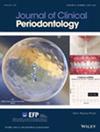在种植体周围条件下分析细菌微生物组
IF 6.8
1区 医学
Q1 DENTISTRY, ORAL SURGERY & MEDICINE
引用次数: 0
摘要
目的全面表征种植体周围健康、种植体周围粘膜炎和种植体周围炎中的细菌微生物群。材料和方法对来自15项研究的原始微生物组数据进行重新分析,最终根据16S rRNA测序的可用性进行选择。使用mother对Reads进行预处理,并使用HOMD数据库进行分类。共分析了522个样本,以评估多样性估计和细菌相对丰度,通过LEfSe识别判别特征,同时使用PICRUSt2预测功能潜力。构建细菌共生网络,并采用龈下微生物群落生态失调指数来测量生态失调。结果与健康患者相比,植体炎患者的细菌多样性和微生物丰富度更高。每一种临床情况都显示出不同的群落结构和细菌共现网络。种植期健康有代表性的种有罗氏菌、齿齿绿僵菌和细小细络菌。粘膜周围炎以香港钩毛菌、瓦德氏乳杆菌和核梭杆菌亚种为特征。多态性,而种植体周围炎是由牙龈卟啉单胞菌、具核卟啉单胞菌定义的。连翘属和单宁属。种植体周围炎表现出可预测的微生物发病途径的富集和更大的细菌生态失调。这些结果提供了对种植体周围微生物群的更深入了解,确定了可能对种植体周围疾病的炎症和破坏至关重要的关键细菌种类、功能过程和相互作用。本文章由计算机程序翻译,如有差异,请以英文原文为准。
Profiling the Bacterial Microbiome Across Peri‐Implant Conditions
AimTo comprehensively characterise the bacterial microbiome in peri‐implant health, peri‐implant mucositis and peri‐implantitis.Materials and MethodsA re‐analysis of raw microbiome data was performed from 15 studies, which were finally selected based on the availability of 16S rRNA sequencing. Reads were pre‐processed using mothur and classified using the HOMD database. A total of 522 samples were analysed to evaluate diversity estimates and bacterial relative abundance, identifying discriminant features via LEfSe, while predictions of functional potential were obtained using PICRUSt2. Bacterial co‐occurrence networks were constructed, and dysbiosis was measured by employing the subgingival microbiome dysbiosis index.ResultsPeri‐implantitis showed higher bacterial diversity compared to health and greater microbial richness than peri‐mucositis. Each clinical condition displayed a distinct community structure and bacterial co‐occurrence networks. The representative species in peri‐implant health were Rothia aeria R. dentocariosa Veillonella parvula_dispar . Peri‐mucositis is characterised by Leptotrichia hongkongensis L. wadei Fusobacterium nucleatum polymorphum , while peri‐implantitis is defined by Porphyromonas gingivalis F. nucleatum vincentii and Tannerella forsythia . Peri‐implantitis exhibited enrichment in predicted microbial pathogenesis pathways and greater bacterial dysbiosis.ConclusionsThese results provide deeper insights into the peri‐implant microbiome, identifying key bacterial species, functional processes and interactions that may be crucial to inflammation and destruction during peri‐implant diseases.
求助全文
通过发布文献求助,成功后即可免费获取论文全文。
去求助
来源期刊

Journal of Clinical Periodontology
医学-牙科与口腔外科
CiteScore
13.30
自引率
10.40%
发文量
175
审稿时长
3-8 weeks
期刊介绍:
Journal of Clinical Periodontology was founded by the British, Dutch, French, German, Scandinavian, and Swiss Societies of Periodontology.
The aim of the Journal of Clinical Periodontology is to provide the platform for exchange of scientific and clinical progress in the field of Periodontology and allied disciplines, and to do so at the highest possible level. The Journal also aims to facilitate the application of new scientific knowledge to the daily practice of the concerned disciplines and addresses both practicing clinicians and academics. The Journal is the official publication of the European Federation of Periodontology but wishes to retain its international scope.
The Journal publishes original contributions of high scientific merit in the fields of periodontology and implant dentistry. Its scope encompasses the physiology and pathology of the periodontium, the tissue integration of dental implants, the biology and the modulation of periodontal and alveolar bone healing and regeneration, diagnosis, epidemiology, prevention and therapy of periodontal disease, the clinical aspects of tooth replacement with dental implants, and the comprehensive rehabilitation of the periodontal patient. Review articles by experts on new developments in basic and applied periodontal science and associated dental disciplines, advances in periodontal or implant techniques and procedures, and case reports which illustrate important new information are also welcome.
 求助内容:
求助内容: 应助结果提醒方式:
应助结果提醒方式:


